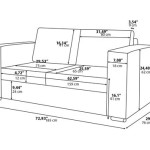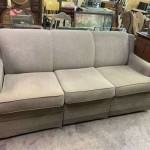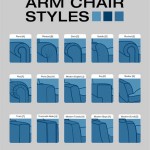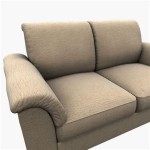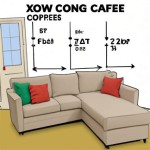The Enduring Appeal of Vintage Two-Seater Sofas
Vintage two-seater sofas represent a unique intersection of furniture design, historical context, and functionality. These pieces, crafted in past decades, offer more than just seating; they embody a specific era, reflecting prevailing aesthetic tastes and manufacturing techniques of their time. The enduring popularity of these sofas stems from their manageable size, distinctive character, and ability to seamlessly integrate into a variety of interior design schemes.
Unlike their larger counterparts, vintage two-seater sofas are well-suited for smaller living spaces, apartments, and even bedrooms. Their compact dimensions allow for flexible placement and prevent them from overwhelming a room. This inherent adaptability makes them a practical choice for individuals seeking to furnish a smaller area without sacrificing style or comfort. The appeal also lies in the affordability; often vintage two-seater sofas can be found at estate sales or antique stores at a lower price point than purchasing a new, larger piece of furniture.
Identifying a truly "vintage" two-seater sofa requires careful examination of several key elements, including its construction, materials, and design. Dates can be determined through manufacturers' marks or tags sometimes found underneath the cushions or on the frame. Understanding these nuances is crucial for both collectors and casual buyers seeking to acquire an authentic piece of furniture history.
Key Features of Vintage Two-Seater Sofa Design
The design of vintage two-seater sofas varies considerably depending on the period in which they were created. However, certain eras and styles are particularly noteworthy and frequently sought after by collectors and enthusiasts. These features contribute significantly to the sofa's overall aesthetic appeal and historical significance.
Mid-Century Modern sofas, popular from the 1940s to the 1960s, are characterized by clean lines, tapered legs, and organic shapes. Materials commonly used in this era include solid wood frames, often made of teak or walnut, paired with upholstery fabrics in bold colors and geometric patterns. The emphasis during this period was on functionality and simplicity, resulting in sofas that are both comfortable and visually striking.
Art Deco sofas, prominent in the 1920s and 1930s, exude elegance and sophistication. These sofas often feature luxurious upholstery materials, such as velvet or silk, embellished with intricate detailing, such as tufting, buttoning, and curved lines. The frames are typically made of hardwoods, and some examples may incorporate metal accents or exotic veneers. The Art Deco aesthetic emphasizes glamour and opulence, reflecting the spirit of the Roaring Twenties.
Victorian-era sofas, dating back to the 19th century, are characterized by elaborate ornamentation, plush upholstery, and curved silhouettes. These sofas often feature rolled arms, deep button tufting, and decorative fringes or tassels. Common upholstery materials include velvet, damask, and brocade, often in rich, saturated colors. The Victorian aesthetic is characterized by a sense of formality and grandeur, reflecting the social customs and values of the time.
The construction methods employed in vintage two-seater sofas are also significant indicators of their age and quality. Hand-crafted frames, dovetail joinery, and meticulous upholstery techniques are hallmarks of older pieces. These details not only contribute to the sofa's structural integrity but also reflect the craftsmanship and attention to detail that were prevalent in past eras. Recognizing these construction features can help distinguish authentic vintage pieces from modern reproductions.
Materials Used in Vintage Two-Seater Sofa Manufacturing
The types of materials used in the construction and upholstery of vintage two-seater sofas varied depending on the period, the intended market, and the available resources. Understanding these materials can provide insights into the sofa's age, origin, and overall quality.
The frames of vintage sofas were commonly constructed from hardwoods such as oak, walnut, mahogany, and teak. These woods were chosen for their durability, strength, and aesthetic appeal. The choice of wood often reflected the style and period of the sofa. For example, Mid-Century Modern sofas frequently featured teak or walnut frames, while Victorian-era sofas often utilized mahogany or oak.
The upholstery materials used on vintage sofas were equally diverse, ranging from natural fibers such as cotton, linen, and wool to luxurious materials such as velvet, silk, and leather. The choice of upholstery material depended on the intended use of the sofa, the prevailing fashion trends, and the desired level of comfort. For instance, durable cotton or linen fabrics were often used for everyday sofas, while velvet or silk were reserved for more formal settings.
The internal padding and cushioning of vintage sofas were typically made from natural materials such as horsehair, cotton batting, and down feathers. These materials provided a comfortable and supportive seating surface. The use of natural materials also allowed for breathability and temperature regulation, enhancing the overall comfort of the sofa. The quality and type of padding can also indicate the sofa's age and original price point.
Spring systems in vintage sofas varied depending on the period and the manufacturer. Coil springs, zig-zag springs, and hand-tied springs were all commonly used. Hand-tied springs, regarded as the highest quality spring system, provided superior support and durability. The type of spring system used can affect the sofa's comfort, longevity, and overall value.
Restoring and Maintaining a Vintage Two-Seater Sofa
Restoring and maintaining a vintage two-seater sofa requires a delicate balance between preserving its original character and ensuring its continued usability. Careful consideration should be given to the condition of the sofa, the desired level of restoration, and the availability of appropriate materials and techniques.
Before undertaking any restoration work, it is crucial to thoroughly assess the condition of the sofa. This includes inspecting the frame for structural damage, examining the upholstery for tears or stains, and evaluating the condition of the padding and springs. A detailed assessment will help determine the scope of the restoration project and identify any potential challenges.
Cleaning vintage upholstery requires a gentle approach to avoid damaging the delicate fibers. Vacuuming the sofa regularly with a soft brush attachment can help remove dust and debris. Spot cleaning stains with a mild detergent and a soft cloth is recommended. Avoid using harsh chemicals or abrasive cleaners, as these can damage the upholstery. Professional cleaning services may be necessary for more extensive cleaning or stain removal.
Repairing or replacing damaged upholstery should be undertaken with care to preserve the sofa's original appearance. If possible, matching the original fabric is ideal, but often finding a similar, historically appropriate fabric may be necessary. Professional upholsterers specializing in vintage furniture can provide expert advice on fabric selection and upholstery techniques. Replacing damaged padding or springs may also be necessary to restore the sofa's comfort and support.
Protecting a vintage two-seater sofa from further damage requires careful attention to its environment. Avoid placing the sofa in direct sunlight, as this can fade the upholstery and weaken the frame. Use coasters and placemats to protect the sofa from spills and stains. Regularly dust and vacuum the sofa to prevent the accumulation of dirt and debris. By taking these precautions, the lifespan of a vintage two-seater sofa can be significantly extended, allowing it to be enjoyed for generations to come.
Acquiring a vintage two-seater sofa can be a rewarding experience, providing a unique piece of furniture that adds character and history to any space. Whether seeking a Mid-Century Modern marvel, an Art Deco masterpiece, or a Victorian-era heirloom, understanding the key features, materials, and restoration techniques associated with these sofas is essential for making an informed purchase and ensuring their longevity.

Hepburn Vintage Velvet 2 Seat Sofa From Old Boot Sofas

Hepburn Shabby Chic Vintage Leather Small 2 Seater Sofa

Ellis 2 Seater Sofa Bespoke Vintage Oak Furniture

Two Seater Sofa 1970s Vintage Floral Theme 1970

Vintage 2 Seater Sofa 1970s For At Pamono

Taylor 2 Seater Sofa Vintage Chestnut

Vintage Sofa Company Granby 2 Seater

Vintage Style Dark Brown Leather 2 Seater Sofa

Hepburn 2 Seater Vintage Sofa

Vintage 2 Seater Sofa 1970s For At Pamono

